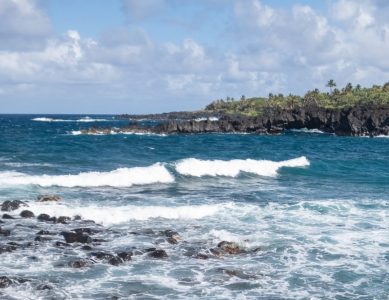Living rurally in Hawai`i is not for everyone, and for most people from urban or temperate environments the adjustment period to a simple, biocentric, tropical lifestyle can pose challenges. Most of our core group chose to reside on the wet side of this tropical island because genuine year-round subsistence living is possible here. Below are information and resources to familiarize you with the most pertinent issues you will encounter.
In terms of fauna, the Hawaiian islands’ relative evolutionary newness combined with their isolation means that there is much less diversity than in the vast majority of other subtropical bioregions. Wild mammals at the elevations we prefer are limited to introduced feral rats, mongooses, and pigs, all of which can carry various diseases of concern.
HEALTH HAZARDS
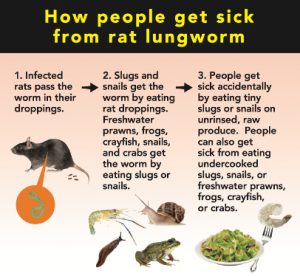 Rat Lung Worm — Careful examination/washing is needed of all produce grown and consumed raw—especially leafy greens—which can harbor slugs containing a fluke that can cause severe and lasting neurological damage. Thorough cooking renders produce safe. This is an additional reason for implementing measures to keep slug populations from infesting garden areas.
Rat Lung Worm — Careful examination/washing is needed of all produce grown and consumed raw—especially leafy greens—which can harbor slugs containing a fluke that can cause severe and lasting neurological damage. Thorough cooking renders produce safe. This is an additional reason for implementing measures to keep slug populations from infesting garden areas.
Leptospirosis — Bodies of water visited by infected animals (cattle, pigs, horses, dogs, rodents) can transmit this bacterial disease to humans. Severe cases can cause kidney and liver damage. Since many homesteads in Hawai`i are on catchment water systems, designs that preclude rodents from accessing gutters and water storage tanks are advised, as are robust water filtration/sterilization systems.
In addition, because of the warm climate, human-to-human transmission of certain diseases is more likely, and can happen during more times of the year. Many are minor annoyances that can be treated with effective herbal or prescriptions medicines and prevented with proper hygiene: Head lice (`ukus), pinworms, or haole rot (Tinea Versicolor). Others are more invasive person-to-person diseases that require knowledge and attentiveness to avoid dangerous infection or protracted and toxic treatment: MRSA (Methicillin-resistant Staphylococcus aureus) and scabies.
PESTS
Luckily, Hawaii is virtually devoid of seriously or lethally venomous animals such as snakes and spiders. Centipedes are probably the most painful biting creature—a full-on bite can hurt excruciatingly for the better part of an hour and swell the area for several days.
Little Fire Ant is a recent South American introduction, which poses a major threat to comfortable enjoyment of vegetative spaces, if infested. Testing for, and treatment of, LFA infestation in our current east Hawai`i neighborhood has become a major focus of time and money. Eradicating LFA from already-infested land is difficult, although not impossible, and border barriers can subsequently be maintained with acceptable success. However, the chemical poisons which are most effective at killing and deterring the LFA are expensive, impact the soil food web, and won’t always be available, so experimentation and development of bio-controls is an important future campaign.
If raising poultry, mongoose control systems are definitely required.
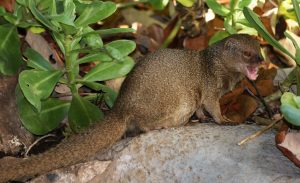
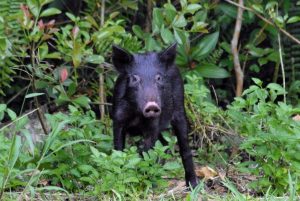
Feral Pigs can destroy all garden vegetables (especially tubers), sapling trees, and even mature trees by gnawing the bark. Pigs also destabilize paths and tear up lawn and sod. Basic preventative awareness and containers are required to keep rats from getting into human and animal feed; having a good hunting cat really helps. In some areas, feral pigs are plentiful enough to be relied upon as a significant food source, providing meats, bone broth, lard, and pet food.
LIFE IN THE HUMID TROPICS
The wet tropics are definitely susceptible to a variety of molds and mildews, to which some people learn that they are sensitive once they live in this climate. Much can be done architecturally, and through regular chores (cleaning of screens and surfaces with potent agents like vinegar) to mitigate mold proliferation.
The majority of us have preferred to live an indoor/outdoor lifestyle, in which dwellings aren’t necessarily enclosed with glass windows and doors. Screens are widely used to keep mosquitos, rodents, and insects out of living spaces. Screened decks (lanais) are commonly attached to main houses. It is important for air flow and ventilation to be maximized through homes, yet to also have systems for battening down living spaces for the occasional tropical storms or hurricanes.
Much of the time, what is most comfortable is to have an easy and permeable transition from outside to inside—for instance, covered outdoor kitchens or uncovered outdoor showers. Sometimes bed houses, bath houses, or composting toilets are configured as separate buildings away from the main living/cooking structure.
As with anywhere that a focus is being kept on growing food, be ready to get dirty! Working the land here presents a trade-off between being fully clothed (long pants, light button-down long-sleeved shirt, close-toed shoes or rubber boots) or more lightly clothed (short, t-shirt, sandals). Some of the vegetation can be quite abrasive, and some can cause minor skin irritations. But long-sleeved work makes for feeling hot and sweaty. Mosquitos are common, but can be kept manageable by diligence to not allow water to pool anywhere (and by populating any permanent body of water with mosquito larvae-eating goldfish). Be ready to move back and forth between work and cover from the frequent rains, or just stay out working (rains are seldom so cold that they can penetrate vigorous labor)! You might take several showers a day, and you will probably regularly sport cuts and scrapes from land work despite any precautions.
POLITICAL LANDSCAPE
It is important for newcomers to know that, although ostensibly organized into Districts, Counties, and a State within the United States of America, Hawai`i is actually, according to international law, an illegally-occupied sovereign state within the League of Nations. We consider it vital that all prospective community founders and members become thoroughly educated about the history of the Hawaiian Kingdom (the first constitutional monarchy in the world with consulates throughout Europe in the mid-1800s), and the imperialist, military takeover by US interests towards the end of the 19th Century. US cultural assumptions about the rights, privileges, and attitudes that private property confers are part of the structural roots of developed nation oppression and colonization of indigenous people worldwide. We don’t step lightly onto Hawaiian soil, and can only do so with any integrity if it is in the spirit of ecological stewardship and active solidarity with the native people of this `aina.

